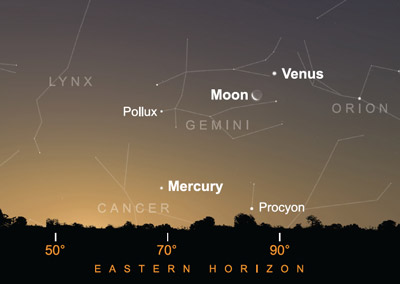



|

|

Inferior planets not so inferior in the morning
BY MARK ARMSTRONG
ASTRONOMY NOW
Posted: 9 August 2012


 Venus and Mercury in the mid-month, morning sky. AN Graphic: Greg Smye-Rumsby.
Venus and Mercury in the mid-month, morning sky. AN Graphic: Greg Smye-Rumsby.
The bulk of the planetary action this month is concentrated in the morning sky, with the 'so-called' inferior planets Venus and Mercury both on show and both reaching greatest elongation west within a day of each other mid-month.
Venus is a beautiful morning star, by far the brightest object in the pre-dawn sky bar the Moon, blazing away at magnitude -4.3 to -4.1 during August. Venus rises at 2am, over three and a half hours ahead of the Sun and by the end of nautical twilight at 5am, it is handily placed some 25 degrees above the eastern horizon. Through a small telescope it exhibits a wide crescent phase just short of half-illumination measuring 25 arcseconds across. Greatest elongation west of the Sun (46 degrees) occurs on 15 August, and that morning its magnitude is a dazzling -4.2 and its half disc has shrunk slightly to 24 arcseconds. From then on it starts to move back towards the Sun; however, at the end of August its window of observation actually has increased, rising four hours ahead of the Sun and well-placed nearly 30 degrees up by the end of nautical twilight at 5.30am. Small telescopes will show a noticeable shrinking of its apparent diameter, down to 20 arcseconds, and a now 58 percent illuminated gibbous phase. It has also faded slightly to mag. +4.1, but its brilliance is such that this is hardly noticeable. The morning of 14 August sees the close attendance of a waning crescent moon within five degrees of Venus, making for a nice photo-opportunity.
Mercury is much more elusive due to its close proximity to the Sun, never straying more than 28 degrees from the Sun and when at its best in the Northern Hemisphere, during eastern elongations in the Spring (evening sky) and western elongations in the Autumn (morning sky), its elongation is only around 18 degrees. All in all, Mercury is a difficult planet to spot and many astronomers have yet to see it. This month is not the most favourable morning apparition (that occurs in late November/early December) but is a pretty decent one at that, and it will be well-worth making an effort to track it down.
Mercury is perhaps best hunted down from the 10 August when it will be about six degrees above the east-north-east horizon at 5am. It shines at a less than impressive magnitude +1.3, but brightens steadily and significantly as the month progresses. Greatest elongation west occurs on 16 August (19 degrees), a day after that of Venus. Then the innermost planet will have brightened to mag. +0.1, exhibit a 40 percent phase spanning 7.5 arcseconds. Half-phase (Dichotomy) occurs on 18 August. It's always a trade-off between Mercury's altitude and magnitude as to when is the best time to spot it; it's altitude at the end of nautical twilight (Sun six degrees below horizon) is at it's best around the 20th, some nine degrees (mag. -0.5), but it will be at its brightest right at the end of August at mag. -1.3. But by this time its altitude is only four degrees at the end of nautical twilight at around 5.30am. The waning crescent moon is close by on the mornings of 15 and 16 August.
One advantage of a morning apparition is the chance to keep on observing Mercury and Venus in the daylight through a driven telescope. If you plan on doing this then great care must be taken to ensure the telescope is not pointed in the Sun's direction as should the Sun enter your 'scope field-of-view while you are looking through the eyepiece, then serious or even permanent damage to your eyesight is the likely outcome.
|

|

|

|
|



